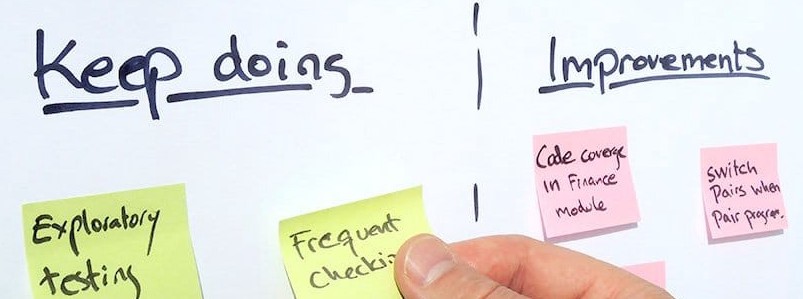Book Review: Agile Retrospectives
 *cough* *cough* Goodness… It’s a bit dusty around here. Nearly a year of silence will do that. One of the goals our
team had last year was to blog more. This effort failed. But, why did it fail? How do we determine what went wrong and
what actions to take to ensure we do better going forward? There happens to be a handy tool in the agile / scrum toolkit
known as the “retrospective”. A mini retrospective of what happened with our blogging might look like this.
*cough* *cough* Goodness… It’s a bit dusty around here. Nearly a year of silence will do that. One of the goals our
team had last year was to blog more. This effort failed. But, why did it fail? How do we determine what went wrong and
what actions to take to ensure we do better going forward? There happens to be a handy tool in the agile / scrum toolkit
known as the “retrospective”. A mini retrospective of what happened with our blogging might look like this.
What did we do well? While we did not generate much content, the content we did generate was something the writer was
passionate about. What could we have done better? We could have encouraged the team to write about anything. It does not
need to be a long, involved post. Just write about something that interested you. How can we improve things going forward?
Have someone leading by example and being a resource to cajole ask people to provide more content in addition to theirs.
This is a simple example from my own mind. Things become more complex when trying to ask these questions from an entire team. The most invaluable resource I have found for learning how to lead retrospectives is Agile Retrospectives: Making Good Teams Great. This is typically one of the books I regularly gift to co-workers.
The book is only 142 pages long but contains a wealth of information and tools to use. It is organized into three sections. First, three chapters are dedicated to explaining how to prepare to lead a retrospective, how to tailor it to your team, and the actual process of the retrospective meeting. The next five chapters outline various activities you could use for each step of the meeting. The final two chapters provide guidance on how to take all these ideas and apply them to lead retrospectives.
The best advice I have for consuming this book is to really absorb the first three chapters and final two chapters. Much of the advice there will help immensely in leading a retrospective and many other meetings. Skim the next five chapters; find a few activities your team might connect best with and start using those. Revisit these chapters every so often to find new activities to keep your retrospectives fresh.
Even if you are not in charge of leading retrospectives or other agile meetings, the advice carries over to leading or participating in other meetings. Also, the retrospective process is a useful tool outside of software development. You can have a retrospective about anything — your recent home renovation project, your car buying experience, your vacation plans. There are few titles I gush over and push onto people. This is one of them, a title I firmly believe should be on every developer’s shelf.

